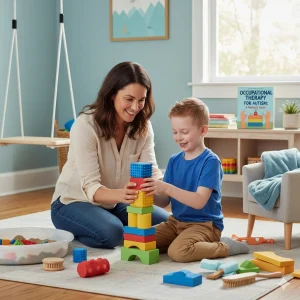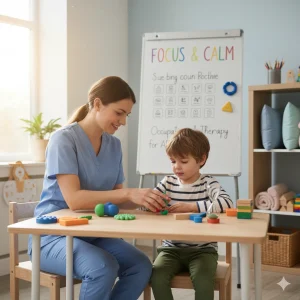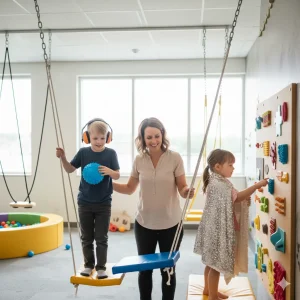Should My 4-Year-Old Be Talking More Clearly by Now?
Last Updated: September 4, 2025
You listen to your child speak every day, but sometimes you wonder: “Should my 4-year-old be talking more clearly by now?” It’s a common worry among parents. At this age, children are full of stories, questions, and playful chatter, yet many still struggle with speech clarity. Some words sound jumbled, and strangers may have a hard time understanding what your child is saying.
By the age of four, most children reach important speech milestones — they can form longer sentences and should be understood by others most of the time. But what if your 4-year-old’s speech isn’t clear? Does it mean there’s a speech delay, or could it simply be part of normal development?
Free Speech Help for Kids
Concerned about speech delays? Book a free consultation with our expert speech therapist and get guidance tailored to your child’s needs.
Normal Speech Milestones at Age 4
By the age of four, most children go through a big leap in speech development. According to the CDC’s developmental milestones, a 4-year-old should be able to string words into longer sentences, share simple stories, and communicate clearly enough for both family members and strangers to understand most of the time. While every child grows at their own pace, there are some common speech milestones at 4 years that can help parents know what to expect.
Also read: Speech Development Milestones: Your Child’s Talking Journey
Typical Sounds Mastered by Age 4
At this stage, children usually pronounce many early-developing sounds like p, b, m, n, t, d, k, g, f, y, and h without much difficulty. You might still notice a few mispronunciations, especially with trickier sounds like r, th, sh, or l — and that’s completely normal. Mastery of these harder sounds often comes later, closer to age 5–7.
How Much Should Strangers Understand?
Speech experts use something called the “intelligibility rule of fours.” This means that:
- At age 1, parents understand about 25% of what a child says.
- At age 2, about 50%.
- At age 3, about 75%.
- And by age 4, strangers should understand 90–100% of a child’s speech.
So, if your child is talking in sentences but still mixes up sounds here and there, that can be within the normal range — as long as most people can follow what they’re saying.
When Speech Clarity Improves Naturally
For many children, speech clarity improves steadily between ages 3 and 5. As they gain better control of their mouth muscles and hear more words in conversations, their pronunciation naturally gets clearer. By the time a child heads into kindergarten, parents often notice a big difference in how easily others can understand them.
Remember, occasional mispronunciations or “cute” speech errors are part of normal child speech development at 4 years. What matters most is progress — your child should be easier to understand now than they were at age three, and even clearer as they approach five.
Also read: Boost Your Child’s Speech Clarity: Tips & Fun Games
How Clear Should a 4-Year-Old Talk?
By the time children turn four, their speech should be much easier to follow than it was just a year ago. But parents often wonder, “How clear should a 4-year-old talk?” The answer lies in understanding speech intelligibility percentages — a way experts measure how much of a child’s speech others can understand.
Average Speech Intelligibility at Age 4
- For parents and caregivers: You should be able to understand nearly everything your child says. Small mispronunciations or “funny” sound substitutions are common, but their meaning should be clear to you.
- For strangers: The 4-year-old speech intelligibility percentage should be around 90–100%. This means that even people who don’t spend much time with your child should understand most of their words and sentences without too much guessing.
If strangers regularly struggle to follow your child’s speech, it may be worth keeping an eye on, especially if frustration is building for your little one.
Examples of What a 4-Year-Old Should Say Clearly
At this age, most children can put together 4–6 word sentences and express ideas like:
- “I want to play outside.”
- “My teddy is sleeping.”
- “Can I have more juice?”
- “We went to the park today.”
You might still hear simplifications, like saying “wabbit” instead of “rabbit,” or “tat” instead of “cat.” These are normal at this stage, as long as the sentence as a whole can be understood. The key is that your child’s words are becoming more precise and their speech is easy enough for others to follow.
The Bottom Line
By age four, children should be talking in full sentences that are clear most of the time, even to people outside the family. Occasional slip-ups are expected, but progress in speech clarity is a strong sign that your child is on track.
Why Some 4-Year-Olds Struggle With Clear Speech
It can be worrying to notice unclear speech in a 4-year-old, especially if other children the same age seem easier to understand. But speech clarity develops on a spectrum, and not all difficulties mean there is a serious problem. Sometimes it’s just a part of normal growth, while in other cases it may signal something that needs attention. Let’s look at the most common reasons children may have pronunciation problems or toddler articulation issues at this age.
Normal Phonological Processes
Many young children simplify words while they’re still learning to master complex sounds. For example, saying “wabbit” instead of “rabbit” or “nana” instead of “banana”. These are called phonological processes, and they are completely normal up to a certain age. Most children gradually outgrow them as their speech muscles strengthen and they hear more correct models of speech.
Articulation Disorder vs. Speech Delay
Sometimes, unclear speech comes from more than just natural sound simplifications. An articulation disorder happens when a child struggles to produce certain sounds, even though they should have mastered them by now. For example, consistently leaving off ending sounds (“ca” instead of “cat”). On the other hand, a speech delay refers to when a child’s overall speech skills develop slower than expected. Understanding whether your child is simply delayed or has a specific articulation disorder often requires a professional evaluation.
Hearing or Oral Motor Issues
Hearing plays a big role in speech development. If a child can’t clearly hear certain sounds, they may not pronounce them correctly. Frequent ear infections, untreated hearing loss, or fluid in the ears can all impact clarity. Similarly, oral motor issues — like tongue weakness, difficulty coordinating the lips and jaw, or structural differences (such as a tongue-tie) — can make it harder for a child to form sounds properly.
Red Flags: When Unclear Speech May Signal a Delay
While some mispronunciations are perfectly normal at this age, there are times when unclear speech in a 4-year-old may point to something more serious. Experts often look at specific speech delay signs in preschoolers to decide when an evaluation is needed. Paying attention to these red flags can help you catch potential challenges early and get your child the right support.
Warning Signs to Watch For
- Only parents can understand the child
By age four, a child’s speech should be understandable to strangers most of the time. If only close family members can make sense of what your child says, it may be a sign of delayed articulation at age 4. - Missing many consonant sounds
Occasional sound substitutions (like “wabbit” for “rabbit”) are normal, but leaving out or mixing up a wide range of consonant sounds can point to an articulation disorder. For example, if your child consistently drops the beginning or ending of words, that’s worth noting. - Struggles to put words into sentences
By this age, children should be combining words into clear, short sentences. If your child is still mostly using single words or has trouble forming sentences, it may be more than just unclear pronunciation. - Frustration due to communication breakdown
If your child often gets upset when others can’t understand them, it’s a strong indicator that their speech clarity is impacting daily life. This frustration can affect confidence, social interactions, and willingness to speak.
Why These Signs Matter
Catching these speech delay signs in preschoolers early allows parents to seek help from a speech-language pathologist (SLP). With the right support, most children make strong progress in articulation at age 4 and beyond. The key is to watch for patterns — occasional errors are normal, but ongoing struggles deserve attention.
How Parents Can Help Improve Speech Clarity at Home
Parents play a powerful role in supporting child speech and language development. The good news is, helping your little one communicate more clearly doesn’t require complicated exercises — everyday routines and fun interactions can make a huge difference. If you’re wondering how to help a 4-year-old speak clearly, here are some simple and effective strategies you can start right away.
1. Read Aloud Daily
Storytime is more than just bonding — it’s one of the best tools for speech growth. Reading aloud introduces your child to new sounds, words, and sentence structures. Choose books with rhymes, repetition, and simple storylines, and encourage your child to repeat phrases or finish familiar sentences. This not only strengthens vocabulary but also improves clarity and confidence.
2. Model Clear Speech
Children learn by imitation. When speaking with your child, model clear and slow speech without over-exaggerating. If your child says “tat” for “cat”, you can respond naturally: “Yes, that’s a cat. The cat is soft.” This reinforces the correct sound without making your child feel pressured or corrected too harshly.
3. Try Play-Based Articulation Activities
Speech practice doesn’t need to feel like homework. Use playful activities such as:
- Silly sound games — practice target sounds through rhymes or tongue twisters.
- Pretend play — role-play as a teacher, shopkeeper, or superhero where your child needs to speak clearly to be understood.
- Singing songs — music and rhythm naturally encourage clearer articulation.
Play keeps learning enjoyable and reduces frustration, making speech practice part of your child’s everyday fun.
4. Use Picture Books
Visuals are powerful for teaching. Picture books and hands-on activities designed for early learning can highlight sounds, words, and actions in a way that sticks. Simple tools like flashcards, storybooks, and everyday objects make learning interactive. Games that encourage your child to listen, repeat, and practice help them build skills in a structured but enjoyable way.
The Bottom Line
Supporting child speech and language development at home doesn’t have to feel overwhelming. Through consistent reading, modeling, playful practice, and the right resources, you can gently guide your child toward clearer, more confident speech. Small daily steps add up, and with patience, you’ll notice steady progress.
Conclusion
Every child is unique, and there’s a wide range of what’s normal vs delayed speech at age 4. Some children are easy to understand, while others still mix up sounds — and that’s okay. What matters most is progress. By age four, most kids should reach strong child speech intelligibility by age 4, but if strangers often can’t understand your child, it may be a sign they need extra help. Don’t worry — early support makes a big difference. If you’re concerned, consult a speech-language pathologist for guidance and give your child the boost they need to communicate clearly.
Frequently Asked Questions:
1. Should a 4-year-old be talking clearly?
By age 4, most children should be speaking in sentences that are clear about 90–100% of the time. While small mispronunciations are common, your child’s speech should generally be easy for both parents and strangers to understand. If only you can follow their words, it might be worth checking with a professional.
2. How clear should a 4-year-old talk to others?
A 4-year-old should be understood by strangers most of the time. Parents may naturally “fill in the blanks,” but outside listeners should also catch nearly everything your child says. This is known as the speech intelligibility percentage for age 4, which should be very high.
3. What are normal speech milestones at age 4?
At this age, children usually use sentences of 4–6 words, ask lots of questions, and tell short stories. They should be able to pronounce many basic sounds like p, b, m, t, d, k, and g. More challenging sounds, such as r, th, sh, or l, may still take a few years to develop fully.
4. Why is my 4-year-old’s speech unclear?
There are many possible reasons. For some children, unclear speech is part of normal development as they work through common sound mix-ups (like “wabbit” for “rabbit”). But it can also be caused by articulation issues, hearing problems, or oral motor difficulties. If speech isn’t improving steadily, it may signal a need for extra support.
5. What are the red flags for speech delay in preschoolers?
Warning signs include: if only parents can understand the child, if they are missing lots of consonant sounds, if they struggle to put words into sentences, or if they get frustrated when people can’t understand them. These are key speech delay signs in preschoolers and should not be ignored.
6. Is it normal for my 4-year-old to mispronounce some sounds?
Yes, this is perfectly normal. Many children still replace or skip difficult sounds at this age, and some continue until 6–7 years old. The important part is that the child’s overall speech is mostly clear, and their speech should be improving with time.
7. How can I help my 4-year-old speak more clearly?
You can support child speech and language development with simple daily activities. Read books aloud, model clear speech when responding, and play sound-based games. Picture books and educational apps are also great tools to practice sounds in a fun, engaging way without making it feel like “work.”
8. When should I worry about my child’s speech clarity?
If strangers regularly cannot understand your child, if they rarely use full sentences, or if they show frequent frustration while talking, it may be time to seek help. Early evaluation from a speech-language pathologist can clarify whether your child is simply catching up or may benefit from therapy.
9. Can speech therapy help a 4-year-old talk clearly?
Absolutely. Speech therapy for preschoolers uses fun, play-based activities that make practicing sounds enjoyable. A therapist can identify which sounds or patterns your child is struggling with and create a personalized plan to improve their clarity. Many children show rapid progress once therapy begins.
10. What is the difference between normal vs delayed speech at age 4?
In normal speech at age 4, a child is understood nearly all the time, even if they still mix up a few sounds. In delayed speech, the child may still be difficult for strangers to understand, use shorter phrases instead of full sentences, or show slower progress compared to peers. Spotting the difference helps parents know when to seek guidance.
About the Author:
Shravanaveena Gajula
M.Sc ., Speech and Language Pathology (5+ years of experience)
Shravanaveena Gajula is a dedicated Audiologist and Speech-Language Pathologist with a BASLP and an M.Sc in Speech and Language Pathology. With experience spanning multiple settings, including Wellness Hub and Ashray Akruti, Veena specializes in a wide range of disorders from developmental issues in children to speech and language assessments in adults. Her expertise includes parent counseling, managing speech sound and fluency disorders, and creating individualized therapy programs. Veena is also PROMPT certified and an author of several insightful blogs on speech and language pathology, aiming to educate and assist caregivers in supporting their loved ones.
Book your Free Consultation Today
Parent/Caregiver Info:
Client’s Details:
* Error Message









